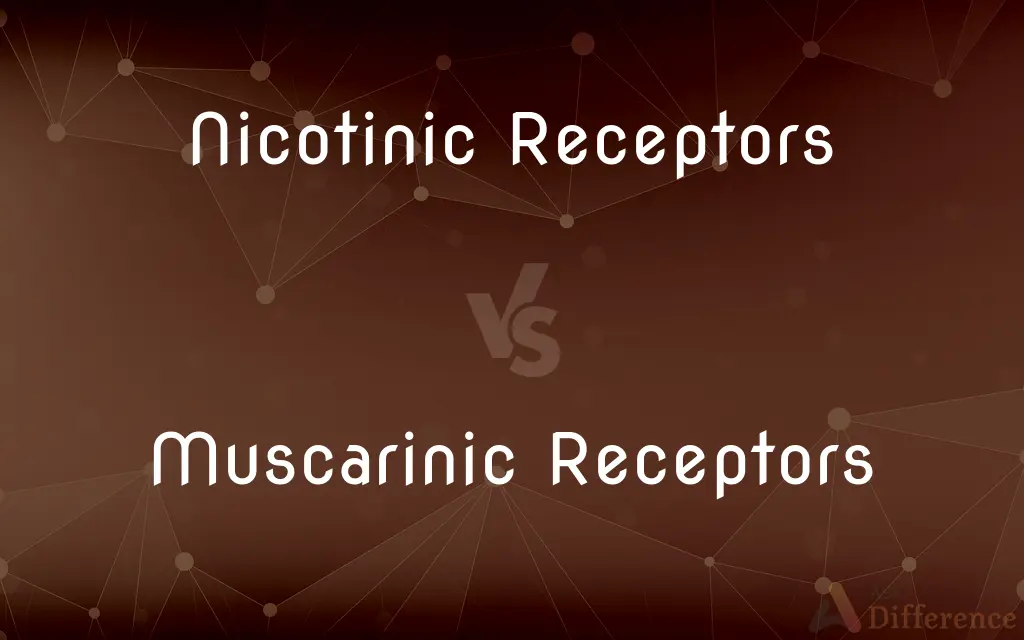Nicotinic Receptors vs. Muscarinic Receptors — What's the Difference?
By Tayyaba Rehman — Published on December 1, 2023
Nicotinic Receptors are ion-channel receptors activated by nicotine, while Muscarinic Receptors are G-protein coupled receptors activated by muscarine.

Difference Between Nicotinic Receptors and Muscarinic Receptors
Table of Contents
ADVERTISEMENT
Key Differences
Nicotinic Receptors and Muscarinic Receptors are both subtypes of cholinergic receptors, which means they are activated by the neurotransmitter acetylcholine. However, they differ in several fundamental ways. Nicotinic Receptors are named for their activation by the alkaloid nicotine. These receptors are ion-channel receptors, allowing ions to pass through when activated. Muscarinic Receptors, on the other hand, are activated by the alkaloid muscarine and are G-protein coupled receptors, which work through intracellular signaling pathways.
Nicotinic Receptors are primarily found at neuromuscular junctions in skeletal muscles and in certain areas of the central nervous system. When acetylcholine binds to Nicotinic Receptors, it leads to an influx of sodium ions, causing depolarization and leading to muscle contraction. In contrast, Muscarinic Receptors are predominantly located in the heart, smooth muscle, and glands. Activation of these receptors can either excite or inhibit cellular activities, depending on the subtype of the receptor and the tissue in which it is found.
A significant distinction between Nicotinic Receptors and Muscarinic Receptors is their response to specific antagonists. Nicotinic Receptors are blocked by agents like curare, which can lead to muscle paralysis. Muscarinic Receptors, however, are inhibited by drugs like atropine, which can affect heart rate and other parasympathetic functions.
Lastly, while both Nicotinic Receptors and Muscarinic Receptors play crucial roles in various physiological functions, their differences in location, mechanism of action, and sensitivity to drugs highlight their distinct roles within the body. They are vital targets for various therapeutic agents, and understanding their nuances is essential for pharmacology and medicine.
Comparison Chart
Activation
Activated by nicotine.
Activated by muscarine.
ADVERTISEMENT
Type
Ion-channel receptors.
G-protein coupled receptors.
Location
Neuromuscular junctions & CNS.
Heart, smooth muscle, & glands.
Response to Antagonists
Blocked by curare.
Inhibited by atropine.
Mechanism of Action
Direct ion channel opening.
Works through intracellular signaling.
Compare with Definitions
Nicotinic Receptors
They are a subtype of cholinergic receptors.
Both muscarinic and Nicotinic Receptors respond to acetylcholine but in different ways.
Muscarinic Receptors
They play a crucial role in the parasympathetic nervous system.
Pupil constriction is a result of Muscarinic Receptor activation in the eye.
Nicotinic Receptors
Nicotinic Receptors are involved in both the peripheral and central nervous systems.
Cognitive functions in the brain can be influenced by Nicotinic Receptors.
Muscarinic Receptors
Muscarinic Receptors can either inhibit or excite cellular activities.
Depending on the subtype, Muscarinic Receptors can either contract or relax smooth muscles.
Nicotinic Receptors
Nicotinic Receptors are ion-channel proteins activated by nicotine.
Smoking introduces nicotine, which stimulates Nicotinic Receptors in the brain.
Muscarinic Receptors
Muscarinic Receptors are G-protein coupled receptors activated by muscarine.
Certain mushrooms contain muscarine that can stimulate Muscarinic Receptors.
Nicotinic Receptors
These receptors directly allow ion flow upon activation.
Binding of acetylcholine to Nicotinic Receptors opens the ion channel.
Muscarinic Receptors
These receptors are primarily found in the heart, smooth muscle, and glands.
Activation of Muscarinic Receptors can slow down the heart rate.
Nicotinic Receptors
They are found primarily at neuromuscular junctions.
Nicotinic Receptors play a role in muscle contraction when activated.
Muscarinic Receptors
They are another subtype of cholinergic receptors, distinct from nicotinic ones.
Atropine, used in eye exams, blocks Muscarinic Receptors to dilate pupils.
Common Curiosities
Are Nicotinic Receptors involved in muscle contraction?
Yes, Nicotinic Receptors at neuromuscular junctions are involved in skeletal muscle contraction.
Are both receptors sensitive to acetylcholine?
Yes, both Nicotinic and Muscarinic Receptors respond to acetylcholine.
What activates Nicotinic Receptors?
Nicotinic Receptors are activated by nicotine and acetylcholine.
What is the mechanism of action for Nicotinic Receptors?
Nicotinic Receptors directly open ion channels upon activation.
How do Muscarinic Receptors influence cellular activity?
Muscarinic Receptors can either excite or inhibit cellular activities through intracellular signaling pathways.
Can nicotine influence cognitive functions?
Yes, nicotine's effects on Nicotinic Receptors in the brain can influence cognitive functions.
Where are Muscarinic Receptors primarily located?
Muscarinic Receptors are primarily located in the heart, smooth muscles, and glands.
How do Muscarinic Receptors affect heart rate?
Activation of certain Muscarinic Receptors can decrease the heart rate.
Do both receptor types play roles in the nervous system?
Yes, both Nicotinic Receptors and Muscarinic Receptors play roles in different parts of the nervous system.
How do curare and atropine differ in action?
Curare blocks Nicotinic Receptors, while atropine inhibits Muscarinic Receptors.
Are there drugs that block Muscarinic Receptors?
Yes, atropine is an example of a drug that blocks Muscarinic Receptors.
How do the receptors differ in their response to acetylcholine?
Nicotinic Receptors open ion channels directly, while Muscarinic Receptors work through G-proteins.
Are Nicotinic and Muscarinic Receptors found in the same locations?
No, while both are cholinergic receptors, they are found in different locations in the body.
Share Your Discovery

Previous Comparison
Africa vs. South Africa
Next Comparison
Oak Wood vs. Teak WoodAuthor Spotlight
Written by
Tayyaba RehmanTayyaba Rehman is a distinguished writer, currently serving as a primary contributor to askdifference.com. As a researcher in semantics and etymology, Tayyaba's passion for the complexity of languages and their distinctions has found a perfect home on the platform. Tayyaba delves into the intricacies of language, distinguishing between commonly confused words and phrases, thereby providing clarity for readers worldwide.
















































